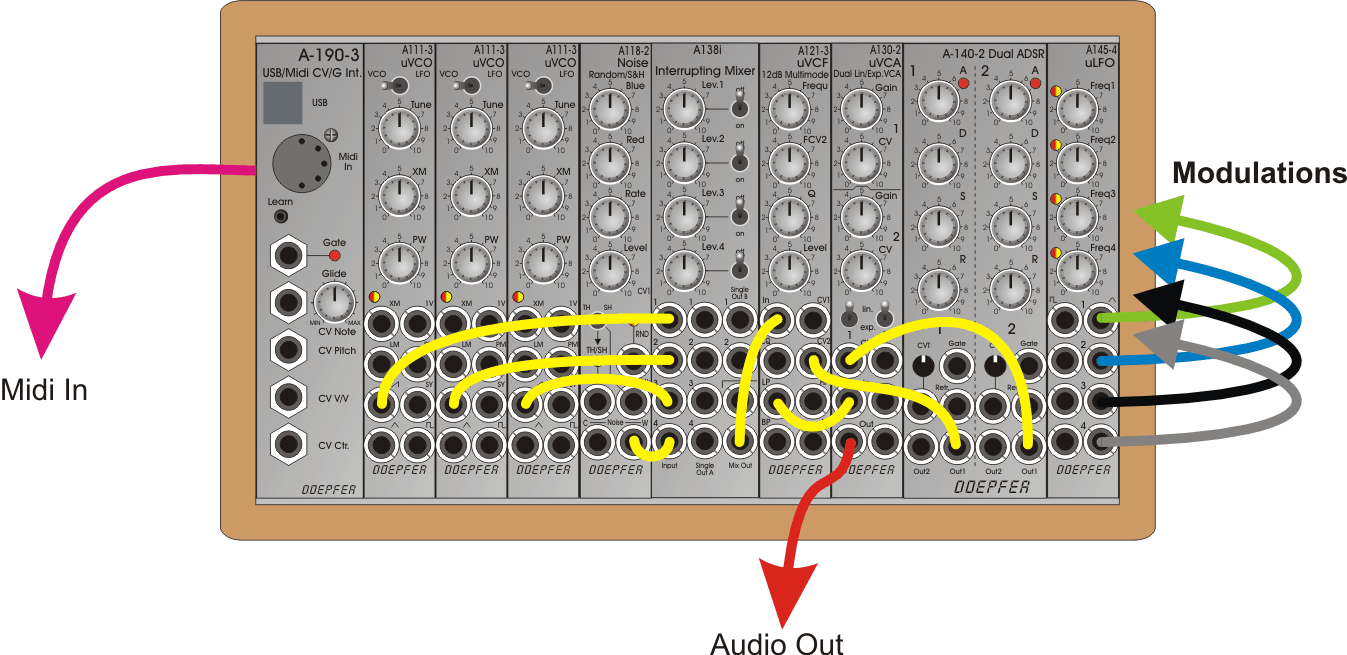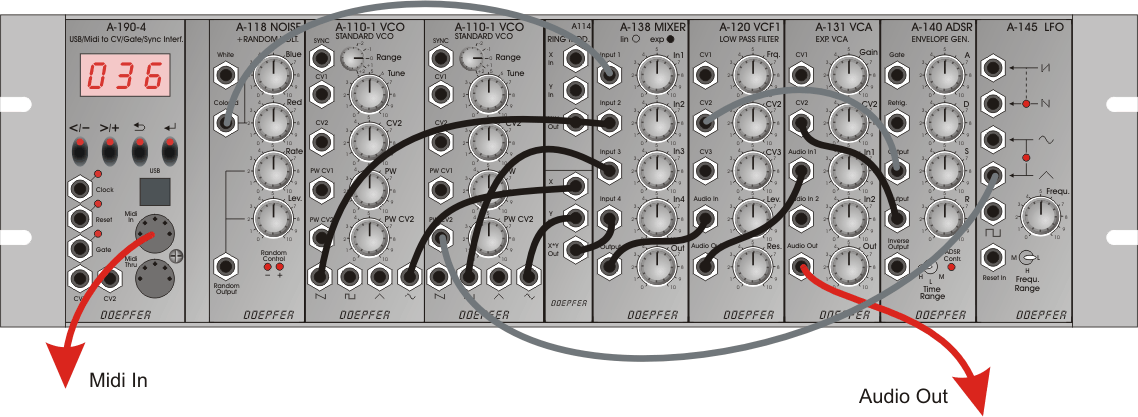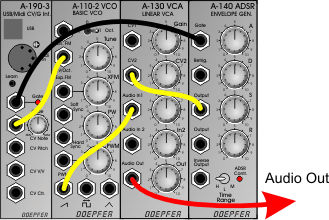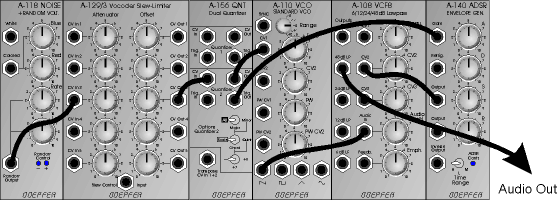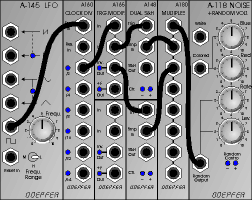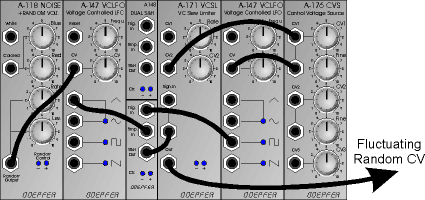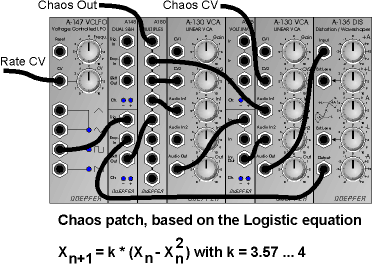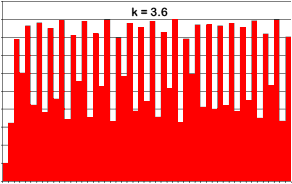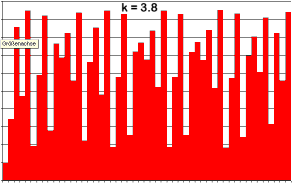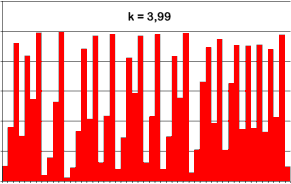|
A-100
Patch Examples |
|||
| We hope that the following patch examples will help for a better understanding of your A-100 system and stimulate you to search for new unusual patches. | |||
|
Classical Standard Synth with 3 VCOs built into an A-100LC1
This is an example for a classical standard synth
with 3 VCOs built into an A-100LC1 case. It contains a midi interface (A-190-3),
three VCOs (A-111-3), a noise/random/S&H source (A-118-2), a (switched)
mixer (A-138i), a VCF(A-121-3), a dual VCA (A.130-2), a dual envelope generator
(A-140-2) and a quad LFO (A-145-4). The sawtooth outputs of the VCOs (A-111-3)
and the noise output (A-118-2) are patched into the 4 inputs of the interrupting
mixer (A-138i). The levels of the signals can be adjusted by means of the level
controls and turned on/off with the corresponding switches. The output of the
mixer is processed by a VCF (A-121-3) and VCA (1/2 A-130-2). Both VCF and VCA
have their own envelope generator (A-140-2). The quad LFO (A-145-4) can be used
for additional modulations (e.g. for FM or PWM of the VCOs, frequency modulation
of the VCF, time modulation of the envelopes, loudness modulation of the VCAs)
or triggering the S&H of the A-118-2 to obtain stepped random voltages for
modulations (e.g. VCF filter frequency). One can play around e.g. with different
VCO waveforms (sawtooth, rectangle, triangle), different filter types (lowpass,
highpass, bandpass, notch) and filter resonance, different flavors of the noise
signal and different settings of the parameters A,D,S and R of the envelope
generators, and different modulation frequencies of the LFOs. The second VCA can
be used e.g. for velocity (CV V/V has to be patched into the CV input of the
second VCA) or additional loudness modulation by means of an LFO or controlling
the deepness of a modulation signal by means of a control voltage (e.g. CV Ctr.
from the midi interface). |
|||
|
Basic Patch A-100 System
This is a basic patch for the A-100 miniature
system (A-100BSM) and can be used as a starting point for other patches. The
patch forms a classical synthesizer voice: Two VCOs (A-110-1), the colored noise
output of the noise module (A-118) and the lower ring modulator output (A-114)
are mixed together in the mixer module (A-138). The output of the mixer module
is processed by the VCF (A-120) and VCA (A-131). The envelope outputs of the
ADSR (A-140-1) are used to control both the filter frequency and loudness. The
triangle output of the LFO (A-145-1) is used to control the pulsewidth of the
second VCO. Therefore the rectangle output of the second VCO is used. The sine
outputs of both VCOs are the inputs of the ring modulator (A-114). Try these modifications and additions:
All modules can be replaced by other modules with similar functions
On the module overview page you find a list of all available A-100 modules. For some of these recommendations it's necessary to add another A-100 housing. That's why we recommend to use larger housings from the beginning (i.e. to reserve free space for additional modules). |
|||
|
Minimal Patch
This is a minimal patch to understand the absolute basic function of an analog synthesizer. The audio output of the VCO (saw output of an A-110-2 in this example) is followed by a VCA (A-130 in this example). The VCA is controlled by an envelope signal that is generated by an ADSR generator (A-140 in this example). The pitch of the VCO is controlled by the CV output of an USB/Midi-to-CV interface (A-190-3 in this example). The gate signal for the ADSR is also generated by the interface module. The patch can be expanded by a VCF that is inserted between the VCO an the VCA and the filter frequency can be controlled manually and/or by the second output of the ADSR. One can play around with different control settings, other waveform outputs of the VCO. The patch works also with other VCOs, other VCAs, other envelope generators and other CV interfaces. The modules shown in this patch are just deputies for the functions VCO, VCA, Envelope generator and USB/Midi-to-CV interface. |
|||
|
Random Melody
This patch creates an automaticially random melody. The sound source is a VCO (A-110) that is processed by a VCF (A-108 in this example but each VCF or VCA will work). The quantized random control voltage for the VCO is generated by the A-118 random output that is processed by one of the A-129/3 Attenuator/Offset Generator and the lower section of the A-156 Quantizer. The rate of change is controlled by the Rate control of the A-118. The basic tone/note is adjusted by the offset control of the A-129/3 and the spread (distance between high and low notes) by the attenuator control of the A-129/3. The setting of the three switches of the A-156 define the type of the random melody (all semitones, only minor or major scale, only tones from chords and so on). The trigger output of the A-156 is used to trigger the A-140 envelope generator for the filter. It is possible to synchronize the patch e.g. with a sequencer. For this the trigger input of the A-156 has to connected to the main clock source. |
|||
|
Sequenced Wavetables
In this patch the two potentiometer rows of the
A-155 sequencer are used to control the pitch (upper row) and the momentary
wavetable (lower low) of an A-112 Sampler/Wavetable Oscillator. And this is how it works: |
|||
|
Toggling Sample&Holds
This patch was inspired by the Buchla 266 Source
of Uncertainty (SOU). It shows how the sample&hold function of the 266 can
be emulated with A-100 modules. And this is how it works: Additional "emulations" of the Buchla 265/266 Source of Uncertainty (SOU) will follow soon. The integrator section of the 266 is nothing but the Voltage Controlled Slew Limiter A-171. Only the "Quantized Random Voltages with 2n and n+1 states" and the "Stored Random Voltages with adjustable probability distribution" could be emulated with already existing A-100 modules (as of December 2003). This is why the A-149-1 Quantized/Stored Random Voltages was developed. New: The toggling S&H function can be realized much easier with the new module A-152 Voltage/Clock addressed Switches/S&H (available ~ summer 2004). |
|||
|
Fluctuating Random Voltages
This is another patch inspired by the Buchla 266 Source
of Uncertainty (SOU). It shows how the "Fluctuating Random Voltages" of the 266 can
be emulated with A-100 modules. And this is how it works: |
|||
|
Chaos Patch
Chaotic patch based on the so-called logistic equation Xn+1 = k*(Xn - Xn2) with k = 3.57 ....4.00. The Xn2 term is realized with the first VCA (A-130) by feeding both the CV and signal input with the same signal coming from the S&H output (A-148). The subtraction is made with the voltage inverter (A-175). The S&H is used to sample the last voltage Xn that is used to create the new voltage Xn+1. It is triggered by a voltage controlled LFO (A-147) that determines the rate of the system (controlled by the external Rate CV). The second VCA is used in combination with the A-136 to create the factor k (3.57 ... 4). As the max. amplification if ~1 for the VCA an additional amplifier has to be used (A-136 with a fixed amplification ~ 4). Even a modified VCA (with modified max. amplification >4) or a VC polarizer (with modified max. amplification >4) could be used. The graphs below show the results for 3 different settings of k.
(attention: so far the patch is theory only, i.e. we did not yet try this patch, comments are welcome to hardware@doepfer.de) In the meantime the patch has been testet sucessfully by one of our customers. We want to thank Willi Sauter for these additional comments (so far in German languge only): Chaos
Patch, Praxis: Hintergrundinformation: |
|||
|
Chopped Vocoder Vocoder with triggered vocal freezing, coming soon .....
|
|||
| If you want to create your own patch examples you could use the A-100 Corel Draw file we have available on our web site. This file contains all A-100 front panels and all you need to create your own patches is Corel Draw (V7 or higher) that is available for a few bugs. You could arrange all front panels at the desired positions (use the "magnetic grid function") and draw in the patch leads. We will be happy to publish your patch at this place (please send us the corresponding Corel Draw file or the pixel file with 440 pixels in height and some explaining words). If you do not have available Corel Draw you could also use the pixel files of the A-100 front panels on our web site to create your own patches (e.g. the pictures in the A-100 module descriptions) with any pixel program (e.g. Photoshop, Paint Shop, Coral Paint). Simply position the mouse above the desired picture and use the right mouse button to save the picture to your computer. |
